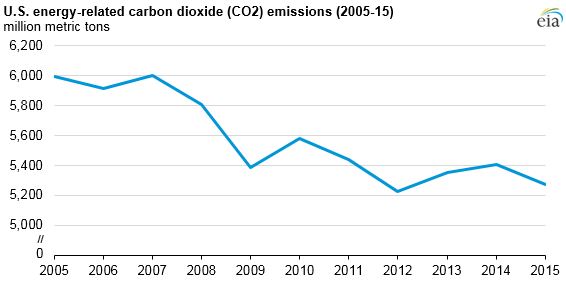Here’s an interesting graph from the federal government’s Energy Information Administration today in a release entitled “U.S. energy-related carbon dioxide emissions in 2015 are 12% below their 2005 levels“:

The EIA explains:
In 2015, U.S. energy-related carbon dioxide emissions were 12% below the 2005 levels, mostly because of changes in the electric power sector.
Energy-related CO2 emissions can be reduced by consuming less petroleum, coal, and natural gas, or by switching from more carbon-intensive fuels to less carbon-intensive fuels. Many of the changes in energy-related CO2 emissions in recent history have occurred in the electric power sector because of the decreased use of coal and the increased use of natural gas for electricity generation.
The reductions in CO2 emissions are spread out among the different end-use sectors in proportion to the share of total electricity sales to each sector. Overall, the fuel-use changes in the power sector have accounted for 68% of the total energy-related CO2 reductions from 2005 to 2015.
I would remind everyone of the very recent push poll by the crony-in-sheep’s-clothing “Clean Energy Conservatives,” which tried very hard to discount the beneficial effects to consumers of electricity brought about by technological change in natural gas.
That is because natural gas is actually responsible for reducing CO2 emissions and lowering consumer costs — things they have been promising will happen some time in the distant-but-not-too-distant future with their clients’ technology.
The poll implied, because it could not truthfully say it openly, that natural gas was bad for the environment:
the poll avoids the fact that the increased use of natural gas is responsible for “significant reductions in the emissions of CO2, NOx, and SO2,” according to researchers at the National Oceanic and Atmospheric Administration. Or that the European Union considers natural gas a “green energy.” Let alone that a Brookings Institute study found solar power to be “by far the most expensive way of reducing carbon emissions” and that “wind is the next most expensive.” By contrast, natural gas does very well in reducing net carbon emissions.
Incidentally, Q12 gives people an option of supporting “looking for low-cost energy sources regardless of environmental impact” (emphasis added). It’s worded that way to suggest all low-cost sources have a negative environmental impact, which is clearly not true.


